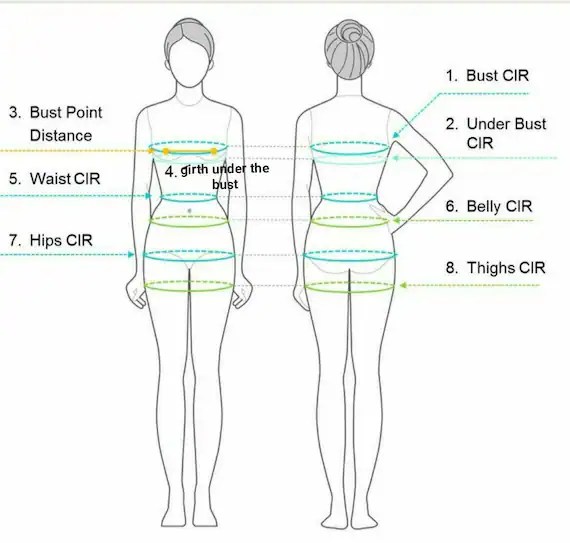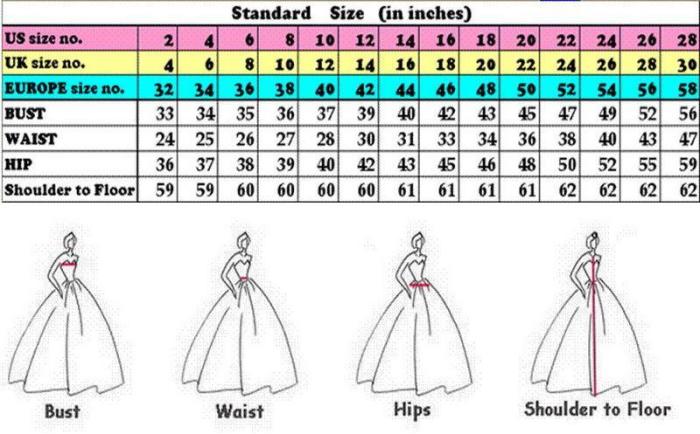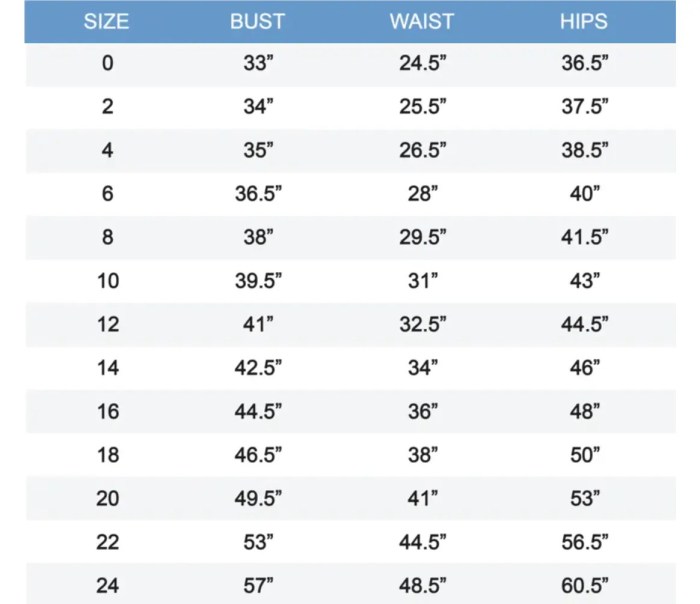Understanding Wedding Dress Sizing
Wedding dress measurement chart – Choosing the perfect wedding dress hinges on accurate sizing. Understanding the nuances of different sizing systems and mastering proper measurement techniques are crucial for a stress-free dress-shopping experience. This section details the intricacies of wedding dress sizing, encompassing various body shapes and international size standards.
Wedding Dress Size Variations Across Countries
Wedding dress sizes vary significantly across the US, UK, and Europe. These differences stem from varying measurement methods and target demographics. A US size 8, for example, might correspond to a UK size 10 or a European size 40. Direct comparison is not always reliable, necessitating careful attention to the specific size chart provided by the designer or retailer.
Essential Body Measurements for Accurate Sizing
Accurate measurements are fundamental to finding the right fit. Key measurements include bust, waist, hips, and hollow to hem (the distance from the hollow of your throat to the floor). Additional measurements, such as shoulder to waist and natural waist to floor, can further refine the fit. The following table summarizes these measurements.
| Measurement | Description | Measurement Technique |
|---|---|---|
| Bust | Measure around the fullest part of your bust, keeping the tape measure level. | Wrap the tape measure snugly around your chest, ensuring it’s parallel to the floor. |
| Waist | Measure around your natural waistline, the narrowest part of your torso. | Place the tape measure around your waist at the point where you naturally bend. |
| Hips | Measure around the fullest part of your hips, keeping the tape measure level. | Wrap the tape measure around the widest part of your hips, ensuring it’s parallel to the floor. |
| Hollow to Hem | Measure from the hollow of your throat to the desired length of your dress. | Use a flexible measuring tape and have someone assist if necessary. |
Body Shape and Wedding Dress Sizing
Different body shapes (hourglass, pear, apple, etc.) require different considerations when selecting a wedding dress size. An hourglass figure, for instance, may need a dress that accentuates the waist, while a pear shape might benefit from a dress that balances the hips and bust. Always consider your body shape when interpreting size charts and choosing a dress style.
| Country | Size 6 | Size 8 | Size 10 | Size 12 |
|---|---|---|---|---|
| US | 34-26-36 | 35-27-37 | 36-28-38 | 37-29-39 |
| UK | 32-24-34 | 34-26-36 | 36-28-38 | 38-30-40 |
| EU | 36-26-38 | 38-28-40 | 40-30-42 | 42-32-44 |
Measurement Techniques

Source: etsystatic.com
Taking accurate body measurements is a critical step in finding the perfect wedding dress. Using the right tools and techniques ensures a precise fit and avoids alterations that could delay the process.
Proper Measurement Techniques
- Gather your supplies: You’ll need a flexible measuring tape, a mirror, and ideally, a friend to assist.
- Wear appropriate undergarments: Wear the same type of undergarments you plan to wear under your wedding dress.
- Stand tall: Maintain good posture, standing straight with your feet together.
- Measure your bust: Wrap the tape measure around the fullest part of your bust, ensuring it’s level and comfortable.
- Measure your waist: Find your natural waistline (the narrowest part of your torso) and wrap the tape measure around it.
- Measure your hips: Wrap the tape measure around the fullest part of your hips, keeping it level.
- Measure hollow to hem: Have someone measure from the hollow of your throat to the floor, keeping the tape measure straight.
- Record your measurements: Write down each measurement clearly, noting the units (inches or centimeters).
Importance of Proper Measurement Technique
Accurate measurements are paramount to avoid ill-fitting gowns. Incorrect measurements can lead to alterations, delays, and potentially an unsatisfactory fit. Using a mirror allows for self-checking, ensuring the tape measure is positioned correctly. A friend can help with measurements that are difficult to take independently.
Interpreting a Wedding Dress Measurement Chart
Understanding how to interpret a wedding dress size chart is essential for selecting the correct size. Charts vary by designer and retailer, so it’s crucial to understand the specific chart you’re using. This section will guide you through the process.
Deciphering Size Ranges and Corresponding Measurements

Source: made-in-china.com
Wedding dress size charts typically list size ranges (e.g., 2-4, 6-8, 10-12) with corresponding bust, waist, and hip measurements. Find the range that best matches your measurements. If your measurements fall between sizes, it’s best to choose the larger size to ensure a comfortable fit. Consider the style of the dress, as some styles accommodate more variance than others.
Comparing Different Types of Wedding Dress Size Charts

Source: shgcdn.com
Size charts vary across designers, bridal shops, and online retailers. Some charts use standard US sizing, while others might use UK or European sizing. Always check the chart’s units (inches or centimeters) and the specific measurements provided. Look for charts that include multiple measurements (bust, waist, hips, hollow to hem, etc.) for the most accurate sizing.
Sample Wedding Dress Size Chart
| Size | Bust (inches) | Waist (inches) | Hips (inches) | Hollow to Hem (inches) |
|---|---|---|---|---|
| 6 | 34 | 26 | 36 | 58 |
| 8 | 36 | 28 | 38 | 60 |
| 10 | 38 | 30 | 40 | 62 |
| 12 | 40 | 32 | 42 | 64 |
Addressing Measurement Challenges
Taking accurate measurements can present challenges. This section addresses common issues and provides solutions to ensure accurate sizing.
Common Measurement Issues and Solutions
- Inconsistent Measurements: Repeat measurements several times to ensure consistency. If measurements vary significantly, take the average.
- Difficulty Measuring Certain Areas: Ask a friend for assistance, particularly for hard-to-reach areas like the back.
- Misinterpreting Size Charts: Carefully review the chart’s units and corresponding measurements. If unsure, contact the retailer or designer for clarification.
Frequently Asked Questions (FAQs)
- Q: What if my measurements fall between sizes? A: Choose the larger size to ensure a comfortable fit.
- Q: How important is it to wear the correct undergarments when measuring? A: Very important! Undergarments significantly impact measurements.
- Q: Can I take my own measurements? A: Yes, but having a friend assist is recommended for accuracy.
- Q: What if the dress doesn’t fit perfectly after ordering? A: Most bridal shops offer alterations services.
Visual Aids for Measurement
Visualizing the measurement process enhances accuracy. This section provides detailed descriptions and visual aids to clarify proper measurement techniques.
Ideal Posture and Body Positioning
Stand tall with your feet together, maintaining good posture. Avoid slouching or hunching, as this can affect the accuracy of your measurements. Relax your shoulders and keep your body relaxed but upright.
Understanding Measurement Terminology
“Hollow to hem” refers to the distance from the hollow of your throat (the dip at the base of your neck) to the floor. “Natural waist” refers to the narrowest point of your torso, usually above your belly button. These measurements are crucial for determining the length and fit of your wedding dress.
Measuring Tape Placement, Wedding dress measurement chart
Measure your bust by wrapping the tape measure around the fullest part of your chest, keeping it parallel to the floor. The tape should be snug but not constricting.
Measure your waist at your natural waistline. Place the tape measure comfortably around your waist at the point where you naturally bend sideways.
Measure your hips at the fullest part of your hips, ensuring the tape measure is level and comfortable. This is typically around the widest part of your buttocks.
For “hollow to hem,” place the measuring tape at the hollow of your throat and extend it down to the floor, representing the desired length of your wedding dress.
FAQs: Wedding Dress Measurement Chart
What type of measuring tape should I use?
A flexible, soft measuring tape is best. Avoid rigid tapes that can distort measurements.
Should I wear undergarments while taking measurements?
Yes, wear the type of undergarments you plan to wear with your wedding dress (e.g., bra, shapewear).
What if my measurements fall between two sizes?
Consult with a bridal consultant. They can help determine the best size based on your body shape and the specific dress style.
How often should I re-measure myself?
Re-measure a week or two before your final fitting to account for any weight fluctuations.
Can I take my own measurements or should I get help?
While you can take your own measurements, having someone else help ensures greater accuracy, especially for back measurements.
